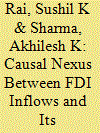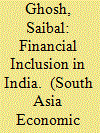|
|
|
Sort Order |
|
|
|
Items / Page
|
|
|
|
|
|
|
| Srl | Item |
| 1 |
ID:
175348


|
|
|
|
|
| Summary/Abstract |
This article aims to understand the drivers of foreign direct investment (FDI) inflows and its nexus with its determinants such as economic growth, inflation rate, labour productivity, infrastructure development, market size, openness of the economy, political stability and corporate tax for South Asian Association for Regional Corporation (SAARC) countries. The article is based on secondary data from the World Bank and International Labour Organization (ILO) for 19 years from 2001 to 2018 for 6 SAARC countries, viz. Bangladesh, Bhutan, India, Nepal, Pakistan and Sri Lanka. The findings indicate that there exists long-run, short-run and joint causal relationship among infrastructure development, market size, openness of the economy, political stability and corporate tax and FDI inflows. Among these variables, the corporate tax is the most important one because it shows bidirectional causality with FDI inflows in the long run as well as short run along with joint strong causality. However, only the coefficients of infrastructure development and corporate tax were found to be positively and negatively significant, respectively. Therefore, better infrastructure development and decrease in corporate tax may enhance FDI inflows in SAARC countries. This infers that with the decrease in corporate tax, more FDI inflows may take place, and higher FDI inflows may decrease in corporate tax further. Therefore, this article suggests that SAARC countries should accelerate the process of integration of their economy with the rest of the world along with political stability, enhance the infrastructure facility and reduce the corporate tax to get the higher FDI inflows.
|
|
|
|
|
|
|
|
|
|
|
|
|
|
|
|
| 2 |
ID:
175352


|
|
|
|
|
| Summary/Abstract |
Per capita availability of water is a serious challenge for Pakistan, like other countries. The objectives of this study are to investigate the different sources of water supply use by Pakistan’s urban households, their willingness to pay and modelling the determinants of the households’ budget allocation for water consumption. The study employed Pakistan Social and Living Standards Measurement (PSLM) 2015–2016 data set, which revealed that more than 60 per cent of households rely on piped water. The result of the variable filtration plant shows that urban households take less care of their health because the tendency of filtered water use is low. The regression result shows negative effect of per capita income, and positive effect of square of per capita income reflects that measures to accelerate income will help to increase budget allocation for water supply at the households’ level. The findings call for accelerating the water filtration plants, water availability in tap and higher incomes while controlling the population size and shared common washroom can help to save water in the case of urban Pakistan.
|
|
|
|
|
|
|
|
|
|
|
|
|
|
|
|
| 3 |
ID:
175350


|
|
|
|
|
| Summary/Abstract |
This article aims to find out interlinkages between equity and commodity markets through the channel of investors’ outlook in the equity market. The proxies used for gauging perception of investors are investor sentiment index and Advance–Decline ratio. The study also incorporates the introduction of Commodity Transaction Tax (CTT) and occurrence of National Spot Exchange Limited (NSEL) scam in the year 2013. Additionally, returns in commodity market are examined to be a function of equity returns. The empirical findings suggest that the liquidity of commodity futures is inversely related to investor sentiments in equity market, and commodity returns are also negatively related to equity returns. Therefore, equity and commodity markets are inversely related, as liquidity in both the markets reacts to the investor sentiments; contrarily, commodity returns experience a significantly negative impact from equity returns. Additionally, the results also provide evidence that investor sentiment in equity possesses the ability to predict liquidity in the commodity futures market. The study also suggests that the CTT and NSEL scam have significantly and positively affected the liquidity of the Indian commodity market.
|
|
|
|
|
|
|
|
|
|
|
|
|
|
|
|
| 4 |
ID:
175349


|
|
|
|
|
| Summary/Abstract |
Employing a novel district-level survey data for India, the study investigates the impact of distance on financial inclusion. Using advanced econometric techniques, the findings indicate that distance primarily dampens the use of bank accounts as compared with access. These results are robust irrespective of whether distance is measured in terms of the time taken to reach the banking infrastructure or physical distance. These results are robust to a wide battery of robustness checks. The analysis suggests the need for policy strategies that can address the tyranny of distance towards achieving the financial inclusion goal.
|
|
|
|
|
|
|
|
|
|
|
|
|
|
|
|
| 5 |
ID:
175351


|
|
|
|
|
| Summary/Abstract |
Higher trade costs in developing countries have received enormous attention during the recent past. In this context, it is imperative to revisit the factors contributing to such higher trade costs. This article attempts to explore the major determinants of trade costs conceptually and empirically. Further, the study endeavours to solve the puzzle of higher trade costs in the South Asian perspective. Using panel data of 93 countries from 2007 to 2015, the study tends to uncover major determinants of trade costs between South Asian countries and their two proximate regional blocks, namely Asia-Pacific Economic Cooperation (APEC) and Association of Southeast Asian Nations (ASEAN). In estimating the model, the study prefers to use fixed-effect estimation technique, owing to the results of statistical tests carried out to choose the most appropriate model for the estimation. The findings of the study reveal that trade facilitation, political corruption and financial development affect intra-regional trade costs of South Asia significantly. Trade facilitation influences trade costs between South Asia and ASEAN. Moreover, trade facilitation and financial development affect trade costs between South Asia and APEC. The diagnoses of South Asian intra and inter-regional trade costs can push forward ongoing efforts at unlocking the potential of regional integration as well as global integration of the region.
|
|
|
|
|
|
|
|
|
|
|
|
|
|
|
|
|
|
|
|
|